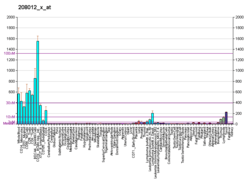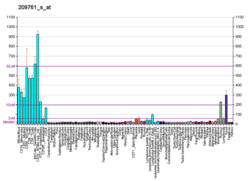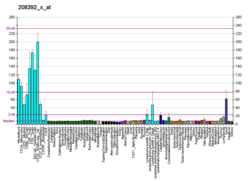SP110 nuclear body protein is a protein that in humans is encoded by the SP110 gene.[4][5][6]
The nuclear body is a multiprotein complex that may have a role in the regulation of gene transcription. This gene is a member of the SP100/SP140 family of nuclear body proteins and encodes a leukocyte-specific nuclear body component. The protein can function as an activator of gene transcription and may serve as a nuclear hormone receptor coactivator. In addition, it has been suggested that the protein may play a role in ribosome biogenesis and in the induction of myeloid cell differentiation. Alternative splicing has been observed for this gene and three transcript variants, encoding distinct isoforms, have been identified.[6]
References
- 1 2 3 GRCh38: Ensembl release 89: ENSG00000135899 - Ensembl, May 2017
- ↑ "Human PubMed Reference:".
- ↑ "Mouse PubMed Reference:".
- ↑ Kadereit S, Gewert DR, Galabru J, Hovanessian AG, Meurs EF (Dec 1993). "Molecular cloning of two new interferon-induced, highly related nuclear phosphoproteins". J Biol Chem. 268 (32): 24432–41. PMID 7693701.
- ↑ Welsh GI, Kadereit S, Coccia EM, Hovanessian AG, Meurs EF (Aug 1999). "Colocalization within the nucleolus of two highly related IFN-induced human nuclear phosphoproteins with nucleolin". Exp Cell Res. 250 (1): 62–74. doi:10.1006/excr.1999.4505. PMID 10388521.
- 1 2 "Entrez Gene: SP110 SP110 nuclear body protein".
Further reading
- Bloch DB, Nakajima A, Gulick T, et al. (2000). "Sp110 localizes to the PML-Sp100 nuclear body and may function as a nuclear hormone receptor transcriptional coactivator". Mol. Cell. Biol. 20 (16): 6138–46. doi:10.1128/MCB.20.16.6138-6146.2000. PMC 86089. PMID 10913195.
- Strausberg RL, Feingold EA, Grouse LH, et al. (2003). "Generation and initial analysis of more than 15,000 full-length human and mouse cDNA sequences". Proc. Natl. Acad. Sci. U.S.A. 99 (26): 16899–903. doi:10.1073/pnas.242603899. PMC 139241. PMID 12477932.
- Izmailova E, Bertley FM, Huang Q, et al. (2003). "HIV-1 Tat reprograms immature dendritic cells to express chemoattractants for activated T cells and macrophages". Nat. Med. 9 (2): 191–7. doi:10.1038/nm822. PMID 12539042.
- Watashi K, Hijikata M, Tagawa A, et al. (2003). "Modulation of retinoid signaling by a cytoplasmic viral protein via sequestration of Sp110b, a potent transcriptional corepressor of retinoic acid receptor, from the nucleus". Mol. Cell. Biol. 23 (21): 7498–509. doi:10.1128/MCB.23.21.7498-7509.2003. PMC 207568. PMID 14559998.
- Nicewonger J, Suck G, Bloch D, Swaminathan S (2004). "Epstein-Barr virus (EBV) SM protein induces and recruits cellular Sp110b to stabilize mRNAs and enhance EBV lytic gene expression". J. Virol. 78 (17): 9412–22. doi:10.1128/JVI.78.17.9412-9422.2004. PMC 506926. PMID 15308735.
- Gerhard DS, Wagner L, Feingold EA, et al. (2004). "The status, quality, and expansion of the NIH full-length cDNA project: the Mammalian Gene Collection (MGC)". Genome Res. 14 (10B): 2121–7. doi:10.1101/gr.2596504. PMC 528928. PMID 15489334.
- Roscioli T, Cliffe ST, Bloch DB, et al. (2006). "Mutations in the gene encoding the PML nuclear body protein Sp110 are associated with immunodeficiency and hepatic veno-occlusive disease". Nat. Genet. 38 (6): 620–2. doi:10.1038/ng1780. PMID 16648851.
- Tosh K, Campbell SJ, Fielding K, et al. (2006). "Variants in the SP110 gene are associated with genetic susceptibility to tuberculosis in West Africa". Proc. Natl. Acad. Sci. U.S.A. 103 (27): 10364–8. doi:10.1073/pnas.0603340103. PMC 1502463. PMID 16803959.
- Thye T, Browne EN, Chinbuah MA, et al. (2006). "No associations of human pulmonary tuberculosis with Sp110 variants". J. Med. Genet. 43 (7): e32. doi:10.1136/jmg.2005.037960. PMC 2564561. PMID 16816019.
- Warren EH, Vigneron NJ, Gavin MA, et al. (2006). "An antigen produced by splicing of noncontiguous peptides in the reverse order". Science. 313 (5792): 1444–7. doi:10.1126/science.1130660. PMID 16960008.
- Szeszko JS, Healy B, Stevens H, et al. (2007). "Resequencing and association analysis of the SP110 gene in adult pulmonary tuberculosis". Hum. Genet. 121 (2): 155–60. doi:10.1007/s00439-006-0293-z. PMID 17149599.
- Babb C, Keet EH, van Helden PD, Hoal EG (2007). "SP110 polymorphisms are not associated with pulmonary tuberculosis in a South African population". Hum. Genet. 121 (3–4): 521–2. doi:10.1007/s00439-007-0335-1. PMID 17287948.
- Cliffe ST, Wong M, Taylor PJ, et al. (2007). "The first prenatal diagnosis for veno-occlusive disease and immunodeficiency syndrome, an autosomal recessive condition associated with mutations in SP110". Prenat. Diagn. 27 (7): 674–6. doi:10.1002/pd.1759. PMID 17510920.
- de la Fuente J, Manzano-Roman R, Blouin EF, et al. (2007). "Sp110 transcription is induced and required by Anaplasma phagocytophilum for infection of human promyelocytic cells". BMC Infect. Dis. 7: 110. doi:10.1186/1471-2334-7-110. PMC 2039740. PMID 17883869.




